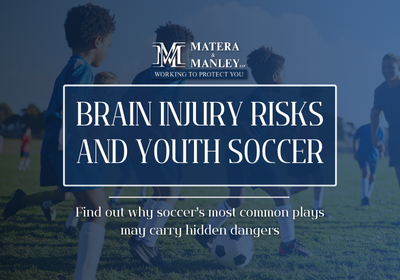Soccer is one of the most popular youth sports on Long Island, with thousands of children playing in school programs and local clubs. For many families, it’s an integral part of their culture and community. But parents know that soccer carries real risks, especially when it comes to head trauma. Unlike a sprained ankle or pulled muscle, a head injury can cause lasting neurological problems, including traumatic brain injury.
How Traumatic Brain Injuries Happen in Soccer
 Head trauma in soccer doesn’t come from one source. There are three primary risks: heading the ball, collisions with other players, and collisions with the ground or goalposts. Each type of impact carries different dangers for young athletes.
Head trauma in soccer doesn’t come from one source. There are three primary risks: heading the ball, collisions with other players, and collisions with the ground or goalposts. Each type of impact carries different dangers for young athletes.
Heading the Ball
Heading is one of soccer’s defining skills, but repeated impacts with the ball can disrupt the brain’s white matter, which connects nerve cells and controls how signals travel. Research from Boston University has shown that frequent heading is linked to memory loss, poor concentration, and mood disturbances. These brain changes occur even without a diagnosed concussion.
On Long Island, where competitive youth leagues often emphasize technical skills like heading, parents need to understand that even routine drills may contribute to long-term neurological problems. Some leagues have limited heading for younger players, but risks remain in older age groups.
Colliding With Other Players
Some of the most severe soccer-related concussions come from player-to-player collisions. Jumping for a high ball can lead to head-to-head contact, but elbows, shoulders, and even accidental knees can create forces strong enough to cause traumatic brain injury.
This is especially concerning in crowded youth games, where aggressive play and limited field supervision may increase the chance of dangerous contact. Coaches and referees have a responsibility to enforce safety and remove injured players immediately.
Colliding With the Ground and Goalposts
Impacts don’t only come from opponents or the ball. A fall during a slide tackle or a bad landing after a jump can cause a child’s head to slam into the ground. Likewise, collisions with the goalpost during a defensive play can cause serious injury. These impacts often look less dramatic than a mid-air collision, but they can still produce concussions and long-term consequences.
For parents, the challenge is recognizing that traumatic brain injury may result from seemingly minor accidents. Coaches and trainers should be trained to recognize these risks and act quickly when they occur.
The Risk of Chronic Traumatic Encephalopathy (CTE)
Repeated head trauma from any source can contribute to chronic traumatic encephalopathy (CTE), a degenerative brain condition. Studies funded by the NIH have shown signs of CTE in young amateur athletes similar to those of professional football players. But the effects of CTE don’t present themselves right away. They can often appear years after the initial injuries, keeping damage hidden until long after a child stops playing. Youth soccer players with CTE may begin to struggle with memory, decision-making, mood swings, impulsivity, apathy, and depression. Because the long-term effects of CTE may not appear until years later, questions of responsibility become even more important when schools, coaches, or leagues fail to take proper precautions after a head injury.
Liability for Soccer-Related Traumatic Brain Injuries
Determining legal responsibility for soccer-related head injuries in New York is not always straightforward. Parents accept some risk when signing permission slips for school or club sports, but that does not excuse negligence.
On Long Island, liability may need to be established if:
-
Coaches ignore concussion protocols and send a child back into play too soon.
-
Trainers fail to evaluate or properly monitor an injured athlete.
-
Schools or clubs fail to provide safe facilities, adequate supervision, or proper equipment.
In these situations, organizations can be held accountable if their actions, or their failure to act, make an injury worse. Because New York has strong negligence standards for schools and youth programs, families in Suffolk and Nassau Counties may have legal recourse if their child suffers a traumatic brain injury due to mismanagement.
Moving Forward With a Traumatic Brain Injury Lawyer
Understanding how these injuries occur and knowing that legal protections exist helps families make informed decisions. If your child has suffered a head injury while playing soccer in Long Island, consulting with an experienced personal injury lawyer can help you understand your options and protect your child’s future. Contact us to schedule a free consultation today, and let us fight for your justice.